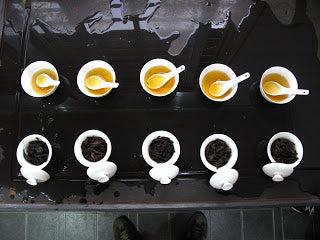Finding a tea master to teach me all about yancha. Part 2 of my Wuyishan Tea Adventure.
Finding the Wuyishan tea expo magazine was a goldmine. After making a few phone calls I had a list of tea producers and their addresses. We were just about to head out in search of these producers, when the hotel phone rang. “There is a man here looking for you” said the front desk. 10 minutes later I was shaking hands with Mr. Yu for the first time. He had driven over to pick us up from the hotel personally rather than wait for us to visit later that afternoon.
In his late 30’s, humble and softly spoken, at first I mistook Mr. Yu for the company driver, but his Columbia all-weather jacket, and Chinese navy commanders cap suggested otherwise. As we drove over to his showroom, he told us he started out as an organic fertilizer salesman, which is how he got to meet all the region’s farmers, understand the variations in terroir and where to source the best teas. Now he is a vertically integrated producer with his own farm, factory & retail stores. The last few years have been especially good for him. His knack for buying the region’s best tea leaves, and processing them into award winning teas was recognized at the Shanghai Expo where he won the gold medal for his traditional Da Hong Pao (传统大红袍 tasting notes available here).

Mr. Yu (on the right) showing off his gold medal trophies
I quickly realized we had stumbled upon a very passionate, modern tea producer. Arriving at his 2 storey tea house, the sweet aroma of roasting tea leaves greeted us at the entrance. Proceeding upstairs we passed through a room full of music stands & gu qin (古琴 a 7 stringed Chinese zither) and another room dedicated to exquisite calligraphy by local & visiting masters. Intricately carved wooden sculptures and a beautiful collection of yixing teapots completed the cultural treasure collection. We spent nearly an hour appreciating his art collection before moving into a tastefully decorated tea room to drink some tea. I was a little bit overwhelmed by the VIP treatment. After all, we had just made a cold call from a print ad!

Guqin music is the perfect accompaniment for a yancha session

Mr. Yu's Chinese calligraphy room
After a few cups of tea to wet the palette, we drove across town to the factory & warehouse, where a several women were separating tea leaves on large bamboo trays and laughing amongst themselves.

Women hand grading tea leaves

Bamboo baskets full of tea about to be roasted over charcoal
The rolling & drying machines were lying idle as it was not picking season but the roasting room was in action, with red hot coals burning silently (and without smoke) under a thick layer of sand coloured ash. Upstairs, we found room after room stacked with boxes of tea. With no computers to manage inventory storage, the names of each tea were scrawled on tiny white labels stuck to each box. Mr. Yu cracked open a few boxes to show us his wares, including a massive disc of pressed black tea. He designed the logo himself, and offered to press a cake with my logo too.

Mr. Yu with a disc of compressed black tea
In the tasting room, his assistant carefully weighed out 5 grams of each tea on an old fashioned scale. 8 gaiwans were pre-heated & used to steep the tea. The tea was then poured out into a bowl so the leaves & liquor could be simultaneously appreciated. We used spoons to scoop tea from the bowl into our tasting cups. Slurping to aerate the tea and open up the flavours, we greedily worked our way through a fragrant (qing xiang清香) and traditional da hong pao (传统大红袍), wild high mountain shui xian (高山野生水仙), an old bush shui xian from wu san di (吴三地老枞水仙), a single bush shui xian (单枞水仙), a light & medium roast rou gui (qing xiang清香 & zhong huo中火肉桂). I was in oolong heaven.

Weighing out 5g of tea for taste testing

Taste testing wuyishan's finest rock oolongs
We then returned to the tea house, where Mr. Yu’s young apprentices taught us the correct way to gracefully serve tea from a gaiwan, without burning or scalding your fingers. It’s all in the angle of the lid, and the quickness of the wrist! An assortment of local guests dropped in - a traditional Chinese doctor, a visiting businessman, and a crackpot historian who joked that he can’t leave China because they might not let him back in. We practiced our gaiwan skills on the guests, with two teenage girls as our instructors. “Don’t tilt your head when you pour!” they barked at me. I used to think the only rule of gaiwan is “don’t burn your fingers!” I quickly discovered the simple act of pouring tea is a highly regulated artform. Serve tea to the eldest first, using two hands to show respect. Pour in a circular fashion, ensuring equal measurements, skipping those who haven’t emptied their cups, and always serve yourself last. Even drinking has its own etiquette. Men should have three fingers on the cup, and ensure the remaining 2 fingers are together. Slowly take 3 sips to empty the cup. You are not allowed to down tea like a tequila shot!
I got to sample more esoterically named teas, such as bai ji guan (white cockscomb 白鸡冠), tie luo han (iron arhat 铁罗汉), a biscuity qi lan (profound orchid 奇兰), fo shou (buddha’s hand 佛手 tasting notes available here), jin que she (gold sparrow’s tongue 金雀舌), and shui jin gui (golden water turtle 水金龟)
Continued in Part 3: Tall Tea Stories

Learning the art of serving tea from a gaiwan

Amazing sculpture carved from tree roots
